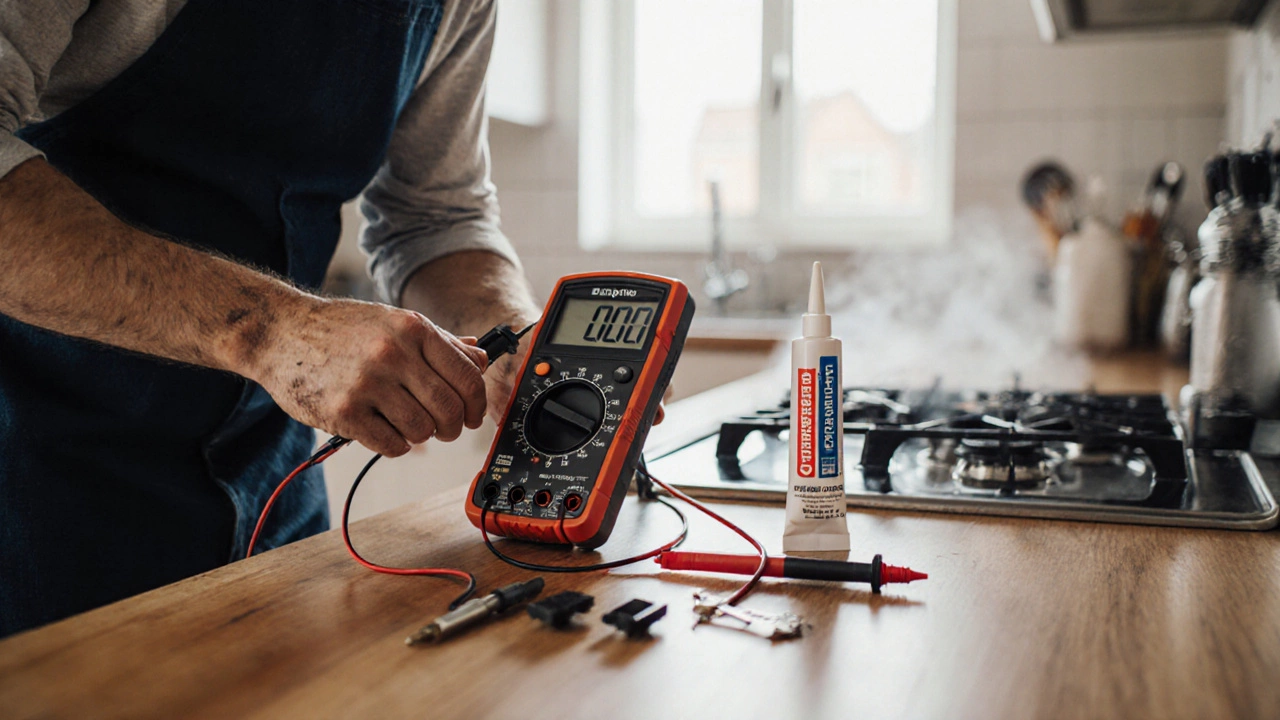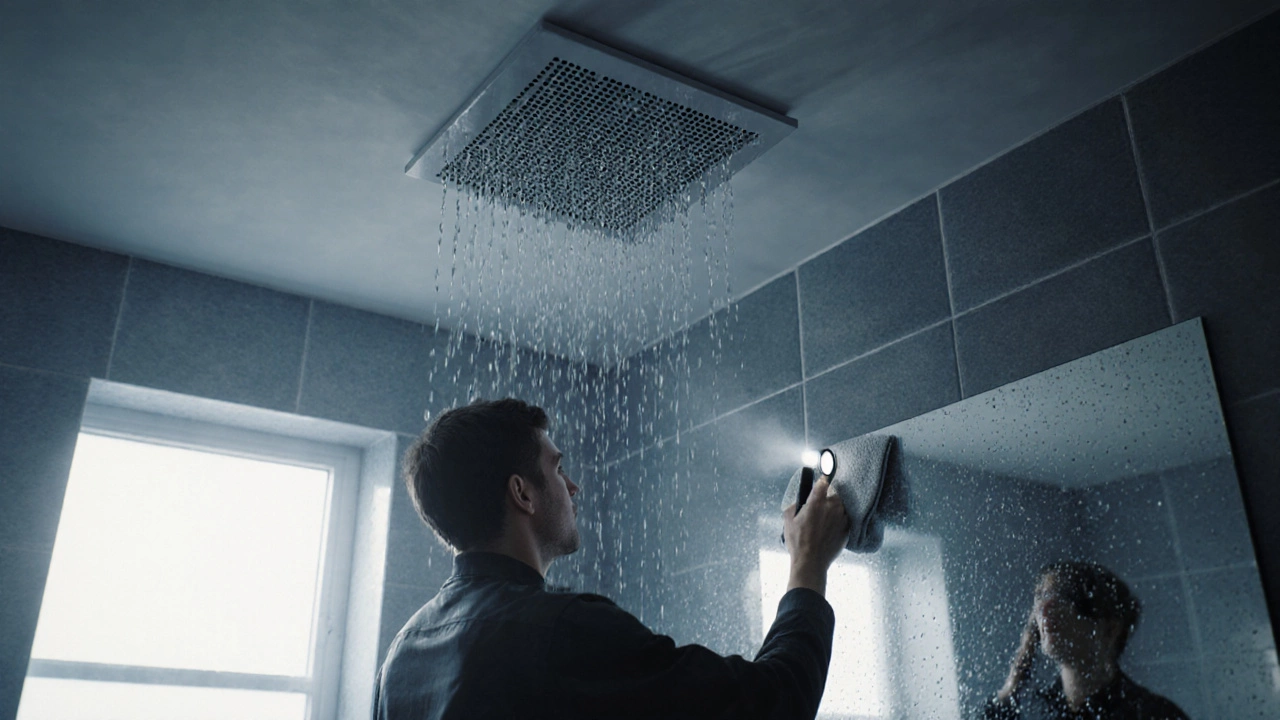
- 24 Nov 2025
- Gideon Thornton
- 0
Ever turned on your kitchen extractor fan and heard nothing but silence? Or worse - a loud grinding noise that makes you wonder if it’s about to launch into orbit? You’re not alone. Thousands of UK households face this exact problem every year. And the big question isn’t just whether it’s broken - it’s whether you should fix it or just buy a new one.
Yes, most kitchen extractor fans can be repaired - if you know what’s wrong
Let’s cut through the noise: extractor fan repair is often possible, and it’s almost always cheaper than replacing the whole unit. But not every issue is fixable. The key is diagnosing the problem correctly. Most failures come down to just three things: the motor, the capacitor, or the switch.
Take a typical 12-year-old extractor fan in a Bristol terraced house. It’s been pulling steam off the stove every day since 2013. Now it’s silent. You check the power - the socket works. The fuse is fine. So what’s dead? More often than not, it’s the capacitor. These small cylindrical components store and release electrical energy to get the motor spinning. When they fail, the fan won’t start - even though the motor itself is still good. Replacing a capacitor costs under £10 and takes 20 minutes. Most DIYers can do it with a screwdriver and a multimeter.
When the motor is the problem - repair still makes sense
Not every motor is beyond saving. If your fan hums but doesn’t spin, that’s usually the motor struggling. Dust buildup is the silent killer here. Over time, grease and kitchen grime clog the bearings. A clean motor with fresh grease can run for another five years. You don’t need to replace the whole unit - just clean the shaft, apply food-safe bearing grease (like white lithium grease), and reassemble.
But if the motor is burnt out - meaning you smell ozone or see blackened wires - then yes, the motor needs replacing. And here’s the good news: most extractor fan motors are standard sizes. A 100mm or 125mm DC motor from a brand like Ebac, Vent-Axia, or Extracta can be bought online for £30-£50. Installation? Still doable with basic tools. You’re not buying a whole new fan - just swapping the heart.
What you should never try to repair
Not everything is worth fixing. If the fan housing is cracked, warped, or rusted through, no amount of motor replacement will fix the underlying issue. Moisture gets in, corrosion spreads, and you’re just delaying the inevitable. Same goes for fans with damaged ducting. If the vent pipe is crushed, disconnected, or blocked by bird nests (yes, this happens more than you think), repairing the fan itself won’t help. Airflow matters just as much as power.
And if your fan is over 15 years old? It’s probably using outdated technology. Older models often run on AC motors that are louder, less efficient, and harder to find parts for. Modern fans use brushless DC motors that are quieter, use 60% less energy, and last longer. If you’re spending more than £70 on repairs for a fan that’s 15+ years old, it’s time to upgrade.
Repair vs replace: The cost breakdown
Here’s what you’re really looking at:
| Option | Cost | Time | Expected Lifespan After |
|---|---|---|---|
| Capacitor replacement | £8-£15 | 20-30 mins | 5-8 years |
| Motor replacement | £30-£60 | 45-60 mins | 5-7 years |
| Professional repair (labour + parts) | £80-£120 | 1-2 hours | 5-7 years |
| New fan (basic model) | £70-£150 | 1-2 hours | 10-15 years |
| New fan (high-efficiency, quiet) | £150-£300 | 1-2 hours | 15+ years |
Notice something? A new fan costs more upfront - but if you’re replacing a fan that’s already 10+ years old, you’re not just buying a new device. You’re buying lower energy bills, quieter operation, and better moisture control. Modern fans pull more air with less noise. Some even have humidity sensors that turn on automatically when you shower.

When to call a professional
You don’t need an electrician for most repairs - unless you’re dealing with wiring. If the fan is wired directly into the mains (not plugged in), and you’re unsure how to safely isolate the power, stop. UK electrical safety rules require isolation before any work. If you’re not confident, hire someone. A qualified electrician will charge £50-£80 for a call-out, but they’ll also check for hidden issues: faulty wiring, earth leakage, or overloaded circuits.
Also, if your fan is part of a whole-house ventilation system - common in newer builds - you might need a certified installer. These systems are often tied to building regulations and require specific airflow ratings. Messing with them yourself could void warranties or even break compliance.
How to test your extractor fan before deciding
Before you spend a penny, do this quick check:
- Turn off the power at the fuse box.
- Remove the fan cover and inspect for thick grease buildup. Clean it with warm soapy water and a soft brush.
- Spin the fan blades by hand. Do they turn smoothly? Or do they grind or stick? Grinding means bearing failure.
- Check the capacitor - it’s a small silver or black cylinder near the motor. Look for bulging, leaking, or cracked casing. If it looks swollen, it’s dead.
- Turn the power back on and listen. If you hear a hum but no spin, it’s likely the capacitor or motor.
That’s it. No fancy tools needed. Just a bit of patience and a flashlight.
What to look for in a replacement fan
If you’re replacing it, don’t just grab the cheapest one on Amazon. Look for these specs:
- CFM rating: Aim for at least 80-100 cubic feet per minute for a standard kitchen. Larger kitchens need 120+.
- Noise level: Below 40 dB is quiet. Above 50 dB is like a running dishwasher.
- Motor type: DC motors are quieter and more efficient than AC.
- Smart features: Humidity sensors, timers, and remote controls add convenience - but aren’t essential.
- Warranty: 5+ years is standard for quality brands like Vent-Axia, Extracta, or Manrose.
Brands like Ebac and Vent-Axia are common in the UK. They’re not flashy, but they’re built to last. Avoid no-name brands from discount stores - they often use cheap motors that burn out in under two years.

Why people regret replacing their fans too soon
I’ve seen too many cases where someone replaces a perfectly fixable fan because they were told it was "not worth repairing." That’s often a sales pitch from a technician who wants to sell a new unit. The truth? Most extractor fans last 10-15 years. If yours is 8 years old and just stopped working, it’s not ancient - it’s middle-aged.
One homeowner in Clifton replaced their 10-year-old fan because the technician said the motor was "unrepairable." They spent £220. Six months later, they found the exact same motor online for £42. They swapped it themselves. The fan’s been running fine since.
Don’t assume repair = cheap fix. Assume repair = smart decision - if the fan is still structurally sound.
Final tip: Keep a spare capacitor on hand
Capacitors fail without warning. If you’ve already replaced one in your fan, keep a spare in a drawer. They’re cheap, last indefinitely if stored dry, and can save you a weekend of no ventilation. It’s like keeping a spare fuse for your toaster - small, simple, and surprisingly useful.
Can I repair my kitchen extractor fan myself?
Yes, if you’re comfortable with basic tools. Most failures - like a dead capacitor or dirty motor - are easy fixes. You’ll need a screwdriver, a multimeter, and maybe a bit of grease. But if the fan is wired directly into the wall, turn off the power at the fuse box first. If you’re unsure about electrical work, call a professional.
Is it cheaper to repair or replace a kitchen extractor fan?
Repairing is almost always cheaper - unless the fan is over 15 years old. Replacing a capacitor costs £10. A new motor is £40-£60. A full replacement fan starts at £70. If your fan is under 10 years old and the housing is intact, repair makes financial sense. If it’s older, consider upgrading for better efficiency and quieter operation.
Why does my extractor fan make a grinding noise?
A grinding noise usually means the motor bearings are worn out or clogged with grease. Clean the blades and shaft, then apply food-safe bearing grease. If the noise returns after cleaning, the bearings are damaged and the motor needs replacing. Don’t ignore it - continued use can overheat and kill the motor completely.
How long should a kitchen extractor fan last?
A well-maintained extractor fan lasts 10-15 years. Regular cleaning every 6-12 months helps prevent grease buildup, which is the #1 cause of premature failure. Fans in high-humidity kitchens (like those with frequent cooking or steam) may need more frequent maintenance.
Do I need an electrician to replace my extractor fan?
Only if the fan is hardwired into the mains. If it’s plugged into a socket, you can replace it yourself. If it’s wired directly, you need to isolate the power safely - and in the UK, that’s best done by a qualified electrician. Also, if your home has a whole-house ventilation system, check the manufacturer’s guidelines - some systems require certified installers.
What brands make the most reliable kitchen extractor fans?
Vent-Axia, Extracta, Manrose, and Ebac are the most reliable brands in the UK. They use durable DC motors, have good warranties (5+ years), and their parts are easy to find. Avoid no-name brands sold at discount stores - they often fail within 1-2 years.
What to do next
If your fan’s silent, don’t panic. Turn off the power. Take off the cover. Look at the capacitor. Spin the blades. Clean the grease. That’s it. You’ve already done half the job.
Most extractor fans aren’t broken - they’re just dirty, forgotten, or misunderstood. Repairing one isn’t just about saving money. It’s about fixing something that still works - instead of tossing it out.
And if you’re still unsure? Take a photo of the model number and search online. Chances are, someone else has fixed the exact same model - and posted a step-by-step video. You don’t need to be an expert. You just need to be willing to look under the hood.




